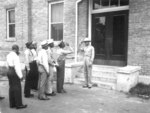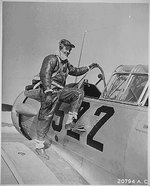Benjamin Davis, Jr.
| Surname | Davis |
| Given Name | Benjamin |
| Born | 18 Dec 1912 |
| Died | 4 Jul 2002 |
| Country | United States |
| Category | Military-Air |
| Gender | Male |
Contributor: C. Peter Chen
ww2dbaseBenjamin Oliver Davis, Jr. was born in Washington, DC, United States to Benjamin Oliver Davis, Sr., an US Army cavalry officer who eventually became the first African-American general in the US Army, and Elnora Dickerson Davis. In 1916, his mother passed away from complications after giving birth to his younger sister. At the age of 14, he had his first flight experience as a passenger, and it sealed his determination to become a pilot. In 1932, he enrolled in the United States Military Academy at West Point, New York, United States after attending the University of Chicago. As an African-American, he never had a roommate at West Point, always ate meals by himself, and never gained a friend, but the racial prejudice against him never deterred him, and he graduated in 1936 as the academy's fourth African-American graduate. As he became an officer in the United States Army, he was one of the only two active African-American line officers in the army at the time, the other one being his father.
ww2dbaseIn 1936, Davis married Agatha Scott.
ww2dbaseDavis joined the US Army 24th Infantry Regiment at Fort Benning, Georgia, United States after being turned down by the US Army Air Corps, which did not accept African-Americans at the time. He later attended the US Army Infantry School at Fort Benning, but then was assigned to teach military tactics at Tuskegee Institute, a African-American college in Alabama, United States. On paper, it was the US Army's respect for his talent in leadership, but in actuality it also had something to do with the unwillingness to put an African-American in command of Caucasian troops. In early 1941, President Franklin D. Roosevelt gave order for the War Department to create an African-American flying unit. Davis, now a captain, finally got his opportunity. He became a part of the first training class at the Tuskegee Army Air Field, and on 7 Mar 1942 qualified for his wings. In Jul 1942, he was promoted to the rank of lieutenant colonel to command the 99th Pursuit Squadron.
ww2dbaseIn the spring of 1943, the 99th Pursuit Squadron was deployed to Tunisia in North Africa with P-40 Warhawk fighters. Their first combat mission took place on 2 Jun 1943, where they dive-bombed German positions on the island of Pantelleria south of Sicily, Italy. They later supported the Allied invasion of Sicily. In Sep 1943, Davis was recalled back to the United States to become the commanding officer of the 332nd Fighter Group. While he prepared 332nd Fighter Group for deployment, some officers in the US Army attempted to remove African-American pilots from the front lines, citing poor performance with the 99th Pursuit Squadron; the pilots of that squadron silenced those officers by shooting down 12 German aircraft in 2 days while protecting the Anzio, Italy beachhead in Jan 1944. Thus, Davis, now a full colonel, was able to continue his preparation of his new unit. Davis received the order to deploy his four-squadron fighter group to Italy in Feb 1944. From the base at Ramitelli, Italy, he and his pilots attacked deep into continental Europe. In the summer of 1945, he was given command of the 477th Bombardment Group based at Godman Field, Kentucky, United States. During WW2, the men commanded by Davis flew 15,000 sorties, shot down 111 hostile aircraft, and damaged or destroyed 273 aircraft on the ground at the cost of only 66 aircraft. He and his pilots also had never lost a bomber to enemy fighters on their escort missions. Davis, in his P-47 Thunderbolt and P-51 Mustang fighters, personally led several combat missions, including a strafing run into Austria that earned him a Silver Star and a bomber-escort mission on 9 Jun 1944 to Munich, Germany that earned him a Distinguished Flying Cross.
ww2dbaseAfter WW2, the United States Air Force was formed from the US Army Air Forces. Because of Davis' leadership in the racial integration plan for the new service branch, the USAF became the first branch to be fully racially integrated. After administrative posts, he became a combat pilot once again in 1953 when he received command of the 51st Fighter-Interceptor Wing during the Korean War; he flew an F-86 Sabre jet fighter. In May 1965, while serving as the chief of staff for American forces in South Korea, he was promoted to the rank of lieutenant general, becoming the first African-American general of the USAF. He was later commander of the Thirteenth Air Force, based in the Philippine Islands, and then the assistant commander of the United States Strike Command with headquarters in Florida, United States.
ww2dbaseDavis retired from military service in 1970 and became the head of the Federal Sky Marshall Program. In 1971, he was named the Assistant Secretary of Transportation for Environment, Safety, and Consumer Affairs. He retired from the Department of Transportation in 1975. In 1978, he served on the American Battle Monuments Commission. In 1991, he published an autobiography titled Benjamin O. Davis Jr.: American. On 9 Dec 1998, President Bill Clinton promoted him to the rank of a full general while on the retired list. He passed away in 2002 at Walter Reed Army Medical Center in Washington, DC, United States. He was buried on 17 Jul 2002 at Arlington National Cemetery.
ww2dbaseSource: Wikipedia.
Last Major Revision: Apr 2008
Benjamin Davis, Jr. Interactive Map
Photographs
 |  |
Benjamin Davis, Jr. Timeline
| 18 Dec 1912 | Benjamin (Jr.) Davis was born. |
| 4 Jul 2002 | Benjamin (Jr.) Davis passed away. |
Did you enjoy this article or find this article helpful? If so, please consider supporting us on Patreon. Even $1 per month will go a long way! Thank you. Share this article with your friends: Stay updated with WW2DB: |
» Invasion of Sicily and Italy's Surrender
- » 1,150 biographies
- » 337 events
- » 43,917 timeline entries
- » 1,241 ships
- » 350 aircraft models
- » 207 vehicle models
- » 375 weapon models
- » 123 historical documents
- » 260 facilities
- » 470 book reviews
- » 28,560 photos
- » 432 maps
James Forrestal, Secretary of the Navy, 23 Feb 1945